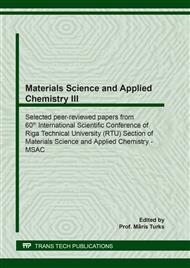[1]
J. Davidovits, Geopolymer Chemistry and Application, 3rd ed., Ins. Geopolymer, France, (2011).
Google Scholar
[2]
V.Q. Le, M.Q. Do, M.D. Hoang, T.P. Dang, T.H. Bui, H.T. Nguyen, Evaluation on Roles of Activated Silicon and Aluminum Oxides for Formation of Geopolymer from Red Mud and Silica Fume, Key Engineering Materials. 777 (2018) 513-517.
DOI: 10.4028/www.scientific.net/kem.777.513
Google Scholar
[3]
H.T. Nguyen, H.L.N. Nguyen, T.N.U. Vo, T.K. Pham, Novel Materials Synthesized from Red Mud, Bagasse, and Bentonite for Gas Treatment by CO2 Absorption, MATEC Web of Conferences 207. 03005 (2018).
DOI: 10.1051/matecconf/201820703005
Google Scholar
[4]
J.L. Provis and J.S.J. van Deventer, Alkali Activated Materials: State of the Art Report. RILEM-TC244 AAM, Springer Dordrecht Heidelberg New York London, (2014).
DOI: 10.1007/978-94-007-7672-2
Google Scholar
[5]
H.T. Nguyen, T.N. Le, V.T.H.Q. Pham, T.P. Dang, T.K. Dao, V.P. Nguyen, Development of Heat Resistant Geopolymer-Based Materials from Red Mud and Rice Husk Ash, AIP Conference Proceedings. 1954 (1) (2018) 040005.
DOI: 10.1063/1.5033414
Google Scholar
[6]
V.Q. Le, M.Q. Do, M.D. Hoang, V.T.H.Q. Pham, H.T. Nguyen, Effect of Alkaline Activators to Engineering Properties of Geopolymer-Based Materials Synthesized from Red Mud, Key Engineering Materials. 777 (2018) 508-512.
DOI: 10.4028/www.scientific.net/kem.777.508
Google Scholar
[7]
Q.M. Do, T.H. Bui, H.T. Nguyen, Effects of Seawater Content in Alkaline Activators to Engineering Properties of Fly Ash-Based Geopolymer Concrete, Solid State Phenomena. 296 (2019) 105-111.
DOI: 10.4028/www.scientific.net/ssp.296.105
Google Scholar
[8]
P.T. Kien, T.T.T. Ly, P.T.L Thanh, T.P.Q. Nguyen, N.H. Thang, M.M.A.B. Abdullah, A Novel Study on Using Vietnam Rice Hush Ash and Cullet as Environmental Materials, MATEC Web of Conferences. 97 (2017) 1-6.
DOI: 10.1051/matecconf/20179701118
Google Scholar
[9]
H.T. Nguyen, V.T.H.Q. Pham, T.P. Dang, T.K. Dao, Leachability of Heavy Metals in Geopolymer-Based Materials Synthesized from Red Mud and Rice Husk Ash, AIP Conference Proceedings. 1954 (1) (2018) 040014.
DOI: 10.1063/1.5033414
Google Scholar
[10]
H.T. Nguyen, V.T.H.Q. Pham, T.N. Le, T.P. Dang, N.K.T. Nguyen, Utilization of Red Mud and Bagasse for Production of Gas Absorption Materials, AIP Conf. Proc. 1954 (1) (2018) 040010.
Google Scholar
[11]
H.T. Nguyen, V.Q. Le, T.H. Bui, V.T.H.Q. Pham, M.Q. Do, Leaching Behavior and Immobilization of Heavy Metals in Geopolymer Synthesized from Red Mud and Fly Ash, Key Engineering Materials. 777 (2018) 518-522.
DOI: 10.4028/www.scientific.net/kem.777.518
Google Scholar
[12]
H.T. Nguyen, N.H. Nguyen, V.T.H.Q. Pham, N.K.T. Nguyen, V.T.A. Tran, T.K. Pham, Engineering Properties of Lightweight Geopolymer Synthesized from Coal Bottom Ash and Rice Husk Ash, AIP Conference Proceedings. 1954 (1), 040009.
DOI: 10.1063/1.5033414
Google Scholar
[13]
H.T. Nguyen, Synthesis and Characteristics of Inorganic Polymer Materials Geopolymerized from Ash of Brickyard, Materials Science Forum. 961 (2019) 45-50.
DOI: 10.4028/www.scientific.net/msf.961.45
Google Scholar
[14]
H.T. Nguyen, Evaluation on Formation of Aluminosilicate Network in Ternary-Blended Geopolymer Using Infrared Spectroscopy, Solid State Phenomena. 296 (2019) 99-104.
DOI: 10.4028/www.scientific.net/ssp.296.99
Google Scholar
[15]
Q.M. Do, N.M. Huynh, V.U.N. Nguyen, N.T.H. Nguyen, D.T.K. Kieu, T.K. Pham, H.T. Nguyen, The Influence of Composition of Raw Materials on Formation of Phenolic Resin from Cashew Nut Shell Waste (CNSW), Defect and Diffusion Forum. 394, 103-108.
DOI: 10.4028/www.scientific.net/ddf.394.103
Google Scholar


